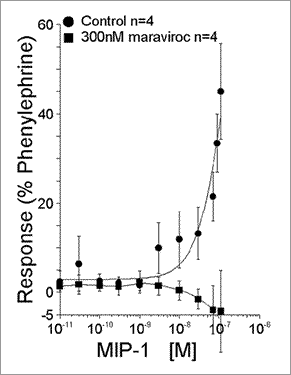Print version
Search Pub Med
 Human SV, obtained with ethical approval, were cut into 4mm rings, mechanically denuded of their endothelium and mounted in 5ml organ baths, containing Krebs’ solution at 37°C, for isometric tension recording. Following normalisation to optimise basal resting tension, removal of the endothelium was confirmed in veins pre-constricted with phenylephrine by the absence of vasodilatation to ACh. Cumulative concentration-response curves (CRC) were then constructed to MIP-1β (10-11-1.1x10-7M). In adjacent rings of SV from some patients, 300nM maraviroc or vehicle (DMSO 0.01%) was added to the bathing medium and cumulative CRC to MIP-1β constructed 30 minutes later. In additional experiments, CRC to MIP-1β were constructed in SV that had been preconstricted with endothelin-1 (10nM) and experiments terminated by addition of 30μM SNAP. Vasoconstrictor responses were expressed as a %phenylephrine and vasodilator responses as %reversal of ET-1 constriction. Data were analysed using FigSys (Biosoft, Cambridge, UK) to determine values of pD2 and maximum response. n-Values are the number of patients from whom tissue was obtained. MIP-1β did not elicit direct vascular smooth muscle relaxation in ET-1 constricted SV, over the concentration range tested. In contrast MIP-1β produced a concentration-dependent contraction of SV with pD2 of 7.70±0.16 (n=12). In the presence of 300nM maraviroc (n=4), the constrictor response to MIP1-β was abolished (Fig 1). We have discovered an as yet unidentified role for the chemokine MIP-1β as a potent constrictor of human SV, an effect mediated through the CCR5 receptor present on vascular smooth muscle.
|
|

